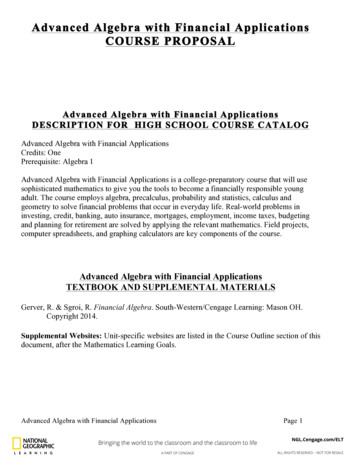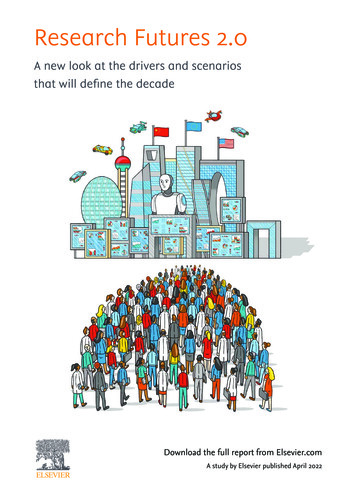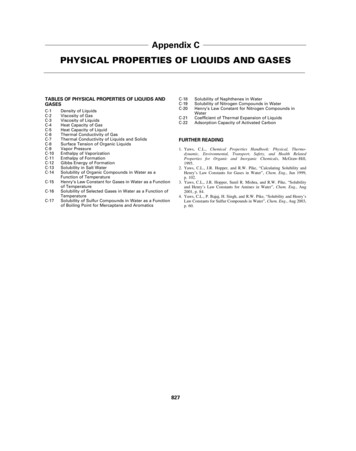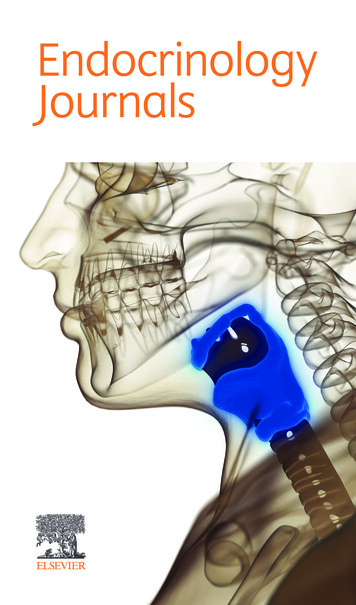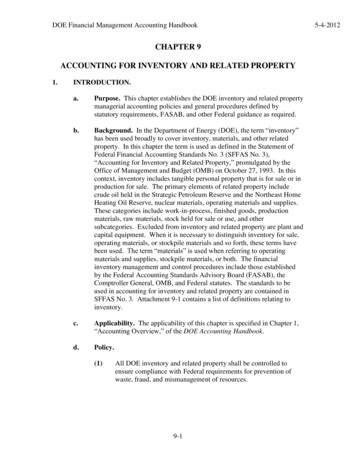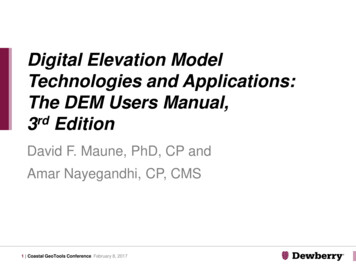
Transcription
E B OOKAdvanced Materialsand Applications:Tackling New R&D andEngineering Challenges
TABLE OF CONTENTSIntroduction31. Faster, Stronger and More Sustainable42. Long-term Success and Profitability73. A Worthy Investment94. Tackling Key Challenges135. Fueling Innovation With Insights156. Putting Customer Value First197. Harnessing Expertise for Technical Feasibility 238. What’s Next for Advanced Materials?26
TA B L E O F C O N T E N T SAdvanced Materials and Applications: Tackling New R&D and Engineering ChallengesINTRODUCTIONLike composites to the Boeing Dreamliner or Gorilla Glass to theSmartphone, the application of an advanced material may be thekey to revolutionizing a product line. But, if you are an engineer orresearcher, how do you keep pace with accelerated market changeand technology developments? How can companies ensure thatnew concepts become commercial successes? This e-book presentskey insights to consider when kick starting R&D and engineeringinitiatives involving advanced materials and applications.
TA B L E O F C O N T E N T SAdvanced Materials and Applications: Tackling New R&D and Engineering ChallengesFaster, Stronger andMore Sustainable
TA B L E O F C O N T E N T SAdvanced Materials and Applications: Tackling New R&D and Engineering ChallengesADVANCED MATERIALS are revolutionizing the way companies dobusiness and demanding that R&D and engineering teams keep up.At any given time, a company or its competitors may launch a newmaterial or application that unlocks revenue potential and marketshare, meets unmet customer needs, achieves profitability goals orsatisfies sustainability and regulatory requirements.Differentiation can be achieved from the molecular level and up—as new materials utilize the research community’s understandingof chemical compound structures and other properties, and can beused to improve product performance, capability and efficiency ofproduction processes.5 1 . FA S T E R , S T R O N G E R A N D M O R E S U S TA I N A B L E
TA B L E O F C O N T E N T SAdvanced Materials and Applications: Tackling New R&D and Engineering ChallengesThe potential for R&D and engineering advancements to make animpact is limitless, and accelerating technology developments requirethat companies constantly pay attention. For instance:Companies can now incorporate advanced materials intothermoplastics that can be used to build fully functional productcomponents using 3-D printers. Small production runs of thesecomponents can either be sold directly to customers or furtherdeveloped to leverage in manufacturing customized, differentiatedproducts at scale.Polymer matrix composites offer manufacturers the opportunity tocreate lighter, stronger and more corrosion resistant products—improving conductivity and durability of products and ultimatelypositively impacting manufacturing and commercial success.Graphene, with its extraordinary and unique combination ofproperties, offers significant potential applications in the field ofelectronics, aerospace, automotive, coatings and paints, energystorage and more.6 1 . FA S T E R , S T R O N G E R A N D M O R E S U S TA I N A B L E
TA B L E O F C O N T E N T SAdvanced Materials and Applications: Tackling New R&D and Engineering ChallengesLong-term Successand Profitability
TA B L E O F C O N T E N T SAdvanced Materials and Applications: Tackling New R&D and Engineering ChallengesTHERE ARE MANY REASONS why companies focus on advancedmaterials development or applications. Some common examples:Reduced costs and increased profitability. Advanced materials that arestronger, lighter and more durable will last longer and save money on replacingparts or can compensate for operational and manufacturing challengesunsolved by relatively less functional materials.Increased customer satisfaction and loyalty. Because of their inherentlyimproved properties, advanced materials can lead to final products that betterfulfill customer requirements and contain fewer defects, which will translateinto increased competitiveness.Regulatory compliance and sustainability. Newer and more stringentregulations are making manufacturing and production more and morearduous. Using advanced materials should help companies comply withregulations without sacrificing performance objectives.8 2 . L O N G -T E R M S U C C E S S A N D P R O F I T A B I L I T Y
TA B L E O F C O N T E N T SAdvanced Materials and Applications: Tackling New R&D and Engineering ChallengesA Worthy Investment
TA B L E O F C O N T E N T SAdvanced Materials and Applications: Tackling New R&D and Engineering ChallengesWHEN PROPERLY APPLIED, the successful synthesis, useand commercialization of advanced materials can help us tacklehumanity’s grand challenges and even improve the human condition.On a global scale, substantial evidence in recent years shows thatboth public and private organizations are willing to invest in this areaand are dedicating resources to research and develop new materialsthat produce and commercialize better finished products.10 3. A WORTHY INVESTMENT
TA B L E O F C O N T E N T SAdvanced Materials and Applications: Tackling New R&D and Engineering ChallengesInside the Advanced Materials Explosion:Global research output is increasing in materials science, showing a 140% growth from 2004 to 2014INCREASE2014 COUNTRY150,000100,00050,00011 3. A WORTHY 04200320022001202000Source: Dr. Stewart Bland, Senior Publisher andEditor of Materials Today. Data derived from Scopus.
TA B L E O F C O N T E N T SAdvanced Materials and Applications: Tackling New R&D and Engineering ChallengesInvestment in New Materials ResearchIn 2013, the Graphene Flagship, the EU’s largest research initiativein history, launched with a budget of 1 billion euros. The initiativebrings together academic and industrial researchers to take graphenefrom the realm of academic laboratories into European society withinthis decade.In October 2014, this movement received further support from theU.S. government, when President Barack Obama announced a 300million investment in emerging technology. Much of this fundingwent to the Departments of Defense, Energy and Agriculture, alongwith NASA, to invest in bio-based materials, advanced sensors anddigital manufacturing.12 3. A WORTHY INVESTMENT
TA B L E O F C O N T E N T SAdvanced Materials and Applications: Tackling New R&D and Engineering ChallengesTackling KeyChallenges
TA B L E O F C O N T E N T SAdvanced Materials and Applications: Tackling New R&D and Engineering ChallengesWHILE THE USE OF ADVANCED MATERIALS offers awide variety of potential benefits, there are still operational anddevelopment roadblocks that the industry must overcome.Some key questions remain unanswered:1. How can researchers, scientists and engineers uncover the datathey need to innovate and problem-solve quickly and efficiently?2. How will companies better ensure that their new products andapplications are commercially viable?3. How can business leaders ensure that they are tackling thetransition of a new material or application from concept tomanufacturing effectively, to meet customer, production andprofitability goals?1 4 4 . TA C K L I N G K E Y C H A L L E N G E S
TA B L E O F C O N T E N T SAdvanced Materials and Applications: Tackling New R&D and Engineering ChallengesFueling InnovationWith Insights
TA B L E O F C O N T E N T SAdvanced Materials and Applications: Tackling New R&D and Engineering ChallengesR&D AND ENGINEERING TEAMS encounter numerousproblems when taking proofs of concept for advanced materialsand applications, and attempting to manufacture them at scaleand commercialize. One such challenge involves accessing reliabledata at the right time, for ensuring the technical feasibility of a newmaterial or application through the stages of the development andmanufacturing process.Lack of sufficient ways to garner insights from data is a commonissue for scientists and engineers. A late 2013 study conducted byOutsell of 200 scientists and engineers revealed that not havingenough time, not knowing what is available, insufficient platformsand lack of access to full text literature are major problems andobstacles when garnering information for their work.1 6 5 . F U E L I N G I N N O VAT I O N W I T H I N S I G H T S
TA B L E O F C O N T E N T SAdvanced Materials and Applications: Tackling New R&D and Engineering ChallengesSmarter data analysis processesand content databases are crucial inenabling R&D and engineering teams.For example, there is an exponentiallyProblems and Obstacles for Engineers and Scientists32%Not enough time37%increasing body of knowledge thatis growing from the exponentiallyincreasing pool of known materialsand compounds. Much of thisdata is in publications, databases,notebooks and spreadsheets--andmust be linked, integrated and madeaccessible to scientists and engineers.37%Hard to know what isavailableToo difficult to get thedesired results/insufficientsearch capabilityFull text is not available24%25%10%16%Q20. [Ask to All}: In general, which of the following factors do you consider to be the threemajor problems or obstacles to getting the information you need to do your work? Base:Engineers (n 100). Scientists (n 100). Source: Outsell’s End-User Study 2013.1 7 5 . F U E L I N G I N N O VAT I O N W I T H I N S I G H T S29%EngineersScientists
TA B L E O F C O N T E N T SAdvanced Materials and Applications: Tackling New R&D and Engineering ChallengesThis need for uncovering insights from unstructured data is alsoechoed more broadly beyond industry, as can be seen from broadinitiatives like the U.S. government’s Materials Genome Initiative,which aims to “create a new era of policy, resources, and infrastructurethat support US institutions in the effort to discover, manufacture, anddeploy advanced materials twice as fast and at a fraction of the cost.”Having a clear strategy for how data is made accessible, discoverableand usable for R&D and engineering teams can significantly helpcompanies more easily and quickly determine the manufacturabilityand economic feasibility of their new products and applications. Asound and systematic data management strategy impacts importantlevers such as testing time and speed to market, employee productivityand product quality.1 8 5 . F U E L I N G I N N O VAT I O N W I T H I N S I G H T S
TA B L E O F C O N T E N T SAdvanced Materials and Applications: Tackling New R&D and Engineering ChallengesPutting CustomerValue First
TA B L E O F C O N T E N T SAdvanced Materials and Applications: Tackling New R&D and Engineering ChallengesSTR ATEGIC COMMERCIALIZATION has become a key focalpoint and challenge, especially as many new product and applicationideas can fail without adequate market demand. Commercialviability requires effectively integrating market needs with R&D andengineering throughout the development process.According to a McKinsey and Company article from 2012 entitled“The path to improved returns in materials commercialization,” themost successful commercialization project leaders approach thischallenge differently than others, digging deeper into the valueproposition of their products and adapting strategic processes toselect the markets they pursue. A practical example of this effort isa tactic known as “strategic segmentation”—a structured process in2 0 6 . P U T T I N G C U S TO M E R VA LU E F I R S T
TA B L E O F C O N T E N T SAdvanced Materials and Applications: Tackling New R&D and Engineering Challengeswhich technical experts and strategic marketers collaborate to findthe best possible market for a new material. This can potentially turna mere idea into a major commercial success.Another way to tackle commercial viability is to understand whatparticular commercial challenges with a new material or applicationare ripe for development and manufacturing challenges. For example,an article by Lux Researcher analyzes the various demands onCeramics by industry and reveals several areas where small changescould have major disruptive impacts in the market. Enterprises thatsolve barriers to commercialization such as cost, processing time,unpredictable failure, shaping/forming capabilities and propertyselection challenges with Structural Ceramics stand to gain significantmarket success.2 1 6 . P U T T I N G C U S TO M E R VA LU E F I R S TThis canpotentially turna mere ideainto a majorcommercialsuccess.
TA B L E O F C O N T E N T SAdvanced Materials and Applications: Tackling New R&D and Engineering ChallengesAnalyzing Challenges Reveals Diverse Areas for DisruptionCost5Automotive (non-wear)4Aerospace (non-engine)3Unpredictable failureRefractory2Processing time1Turbine engines (land)ArmorTurbine engines (aerospace)0High-wearSource: Machinedesign.comShaping/forming2 2 6 . P U T T I N G C U S TO M E R VA LU E F I R S TProperty selectionAnalysis by Lux Researcher into thevarious demands being placed onceramics by industries shows severalareas where small changes couldhave major disruptive impacts.
TA B L E O F C O N T E N T SAdvanced Materials and Applications: Tackling New R&D and Engineering ChallengesHarnessing Expertisefor Technical Feasibility
TA B L E O F C O N T E N T SAdvanced Materials and Applications: Tackling New R&D and Engineering ChallengesINDUSTRY IS EAGER TO TAP into the potential of advancedmaterials but driving technical feasibility from concept to market iscomplex. Proper due diligence from concept to manufacturing is a must.To achieve success, companies must be able to tap into a combinationof in-house and external R&D and engineering experts who collectivelyrepresent an understanding of cutting-edge advanced materials research,the know-how to design and build solutions, best practices on runningand maintaining operations, experience manage teams and businesses,and skills to engage with customers and internal stakeholders.In this context, industry groups that leverage and partner with brightacademic minds and experienced professionals who can develop cuttingedge technologies in relevant materials and science engineering fieldsare at a competitive advantage. In particular, it is vital that R&D and24 7. HARNESSING EXPERTISE FOR TECHNICAL FEASIBILITY
TA B L E O F C O N T E N T SAdvanced Materials and Applications: Tackling New R&D and Engineering Challengesengineering team leaders pay attention to what is going on in the academiccommunity and encourage their scientists and engineers to do the same.This can be done through formal collaboration projects or even informalresearch and networking through access to research databases andplatforms and attending conferences and webinars.An excellent example of a formal collaboration project can be found inthe joint development agreement between the University of Manchester,where graphene was first discovered, and Morgan Advanced Materials, acompany that has 150 years of carbon processing experience. The result is amutually-beneficial partnership that explores the full commercial potentialof graphene, with particular focus on key areas such as optimizing therelationship between the manufacturing process and materials sciencebehind the super material.25 7. HARNESSING EXPERTISE FOR TECHNICAL FEASIBILITY
TA B L E O F C O N T E N T SAdvanced Materials and Applications: Tackling New R&D and Engineering ChallengesWhat’s Next forAdvanced Materials?
TA B L E O F C O N T E N T SAdvanced Materials and Applications: Tackling New R&D and Engineering ChallengesACCORDING TO THEEMERGING TECHNOLOGIESAWARENESS COMMITTEE (ETAC)at ASM International, a survey of 300Emerging Technology Awareness Committee SurveySurveyed several hundred ASM members: 3 materials-related technologies expected to have significant impact 3 process-related developments expected to have significant impactASM member respondents identifiedCategoryTopics% of categorizedresponsesa number of materials-relatedHigh-PerformLight weight, high strength, high temp22%technologies and process-relatedEnergy17%developments that members believedEnergy materials: fuel cells, batteries,solar PVAdditiveAdditive manufacturing, 3D printing13%will significantly impact the world ofNanoNanomaterials, nanomanufacturing12%materials science and engineering inICMEICME and computational modeling9%BIOBiomedical or bio-based materials6%SMARTSmart or multifunctional materials5%ENVIRONMaterials for recovery/reuseor substitution5%SURFACESurface coatings, surface engineering5%METALWORKMetals processing technologies4%JOINWelding, joining3%the future.2 7 8 . W H AT ’S N E X T F O R A D VA N C E D M AT E R I A L S ?
TA B L E O F C O N T E N T SAdvanced Materials and Applications: Tackling New R&D and Engineering ChallengesJournal publications also offerWhat to Watch?a good window into materialsscience and engineering trends andrapidly growing areas of interestand technology development. Dr.Energy storage and generationNext generation Li based batteriesHydrogen storagePhotovoltaicsStewart Bland, Senior Publisher andEditor of Materials Today, also flagsElectronicsa few important materials-relatedTwo-dimensional materialsOrganic electronicsSpintronicsPlasmonicstechnologies to watch, based on whathe is seeing in research trends:BiomaterialsRegenerative medicineDrug deliveryImaging2 8 8 . W H AT ’S N E X T F O R A D VA N C E D M AT E R I A L S ?
TA B L E O F C O N T E N T SAdvanced Materials and Applications: Tackling New R&D and Engineering ChallengesAs advanced materials continue to pave the way for revolutionizingbusiness processes, companies must likewise adapt innovation,development and manufacturing processes. New lessons learnedand opportunities will undoubtedly arise—and the most successfulenterprises will be those that are able to help their R&D andengineering experts recognize and harness the right insights,expertise, processes and resources to support successful developmentand commercialization.To learn more about trends, challengesand opportunities impacting the worldof chemicals and materials, visit:elsevier.com/createwhatsnext2 9 8 . W H AT ’S N E X T F O R A D VA N C E D M AT E R I A L S ?
Advanced Materials and Applications: Tackling New R&D and Engineering Challenges INDUSTRY IS EAGER TO TAP into the potential of advanced materials but driving technical feasibility from concept to market is complex. Proper due diligence from concept to manufacturing is a must. To achieve


